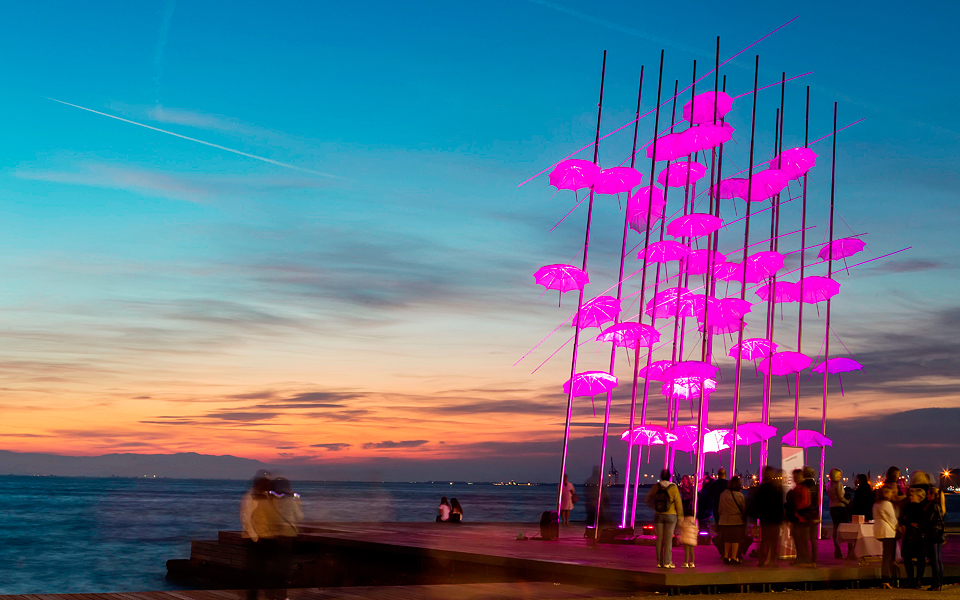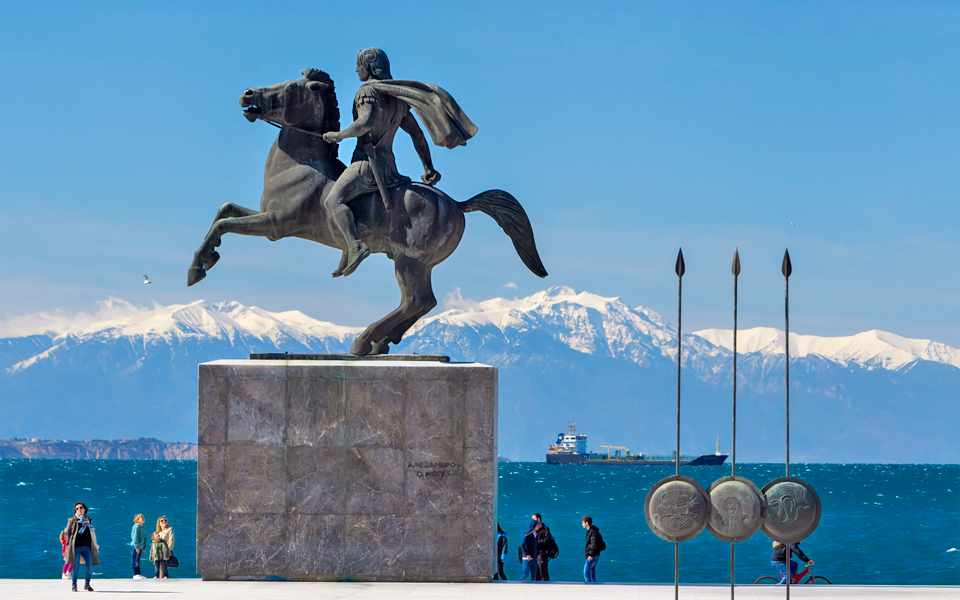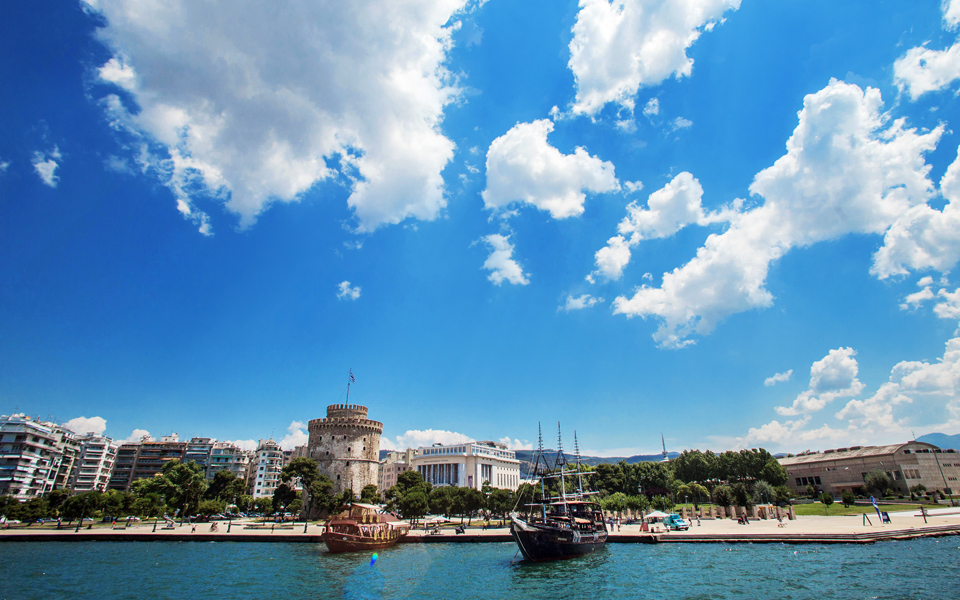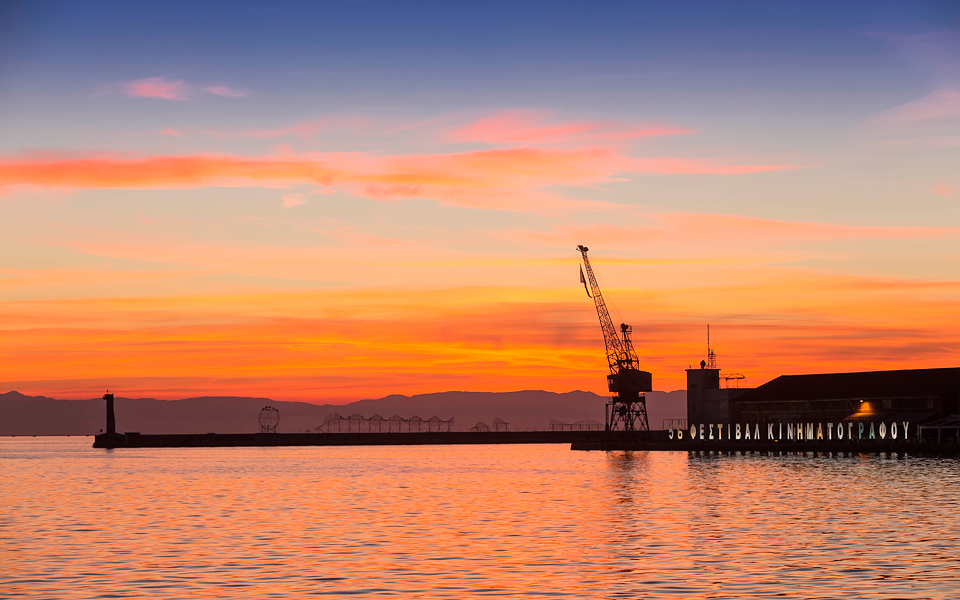In early evening, when the sun begins to set behind Mount Olympus and the great cranes with their dangling cables are silhouetted against a crimson sky, Thessaloniki’s port is transformed into a place of exceptional beauty and is probably the city’s most photographed landscape after the White Tower. When the city’s hectic rhythm has slowed down and the noisy seafront along Nikis Avenue has grown quiet, this is the best time for a stroll.
If you want to experience the city like a local, buy a coffee and sit on one of the seaside benches, surrounded by young couples, solitary readers and students who pass the time waiting for a movie to start at the Thessaloniki Film Festival multiplex. The view of the Concert Hall is impressive. The bars and restaurants clustered at the end of the pier offer a view of the entire Thermaic Gulf, all the way to the former royal palace in Kalamaria in the Karabournaki district. Visible on the other side of the gulf is the new waterfront, the red lights of which dance on the waves along the pier.

Thessaloniki’s appointment as a European Capital of Culture in 1997 was the event that triggered a sea change in the port’s fortunes. Pier 1, until then a dank, filthy place, was transformed into a metropolitan cultural park. The old warehouses, now ablaze with light, became an ideal venue for modern art.
The Museum of Photography, housed in one of these former warehouses at the entrance to the port, hosts interesting exhibitions and its trendy café offers excellent coffee and a large selection of wines. Across the street, the State Museum of Contemporary Art houses exhibitions by internationally acclaimed artists, as well as pieces from the fine arts students of Aristotle University.
A few yards away is the brick building that accommodates the Cinema Museum where International Film Festival events are hosted annually. Directors, producers, actors and journalists from all over the world flock to the city, giving it an air of glamour reminiscent of its colorful past. Greek and foreign documentaries and fiction films are screened in the museum throughout the year.

A harbor with history
The history of the port began approximately 2,300 years ago, when the city was founded by Cassander, a general under Philip II and Alexander the Great who went on to become King of Macedonia.
In Roman times it was a major maritime hub on the Via Egnatia, the Roman road that crossed the Balkans from Dyrrachium (now Durrës in Albania) to Constantinople (now Istanbul). The port was upgraded during the reign of Constantine the Great (306–337), when the first Byzantine emperor built a new rectangular harbor outside the city walls to accommodate 200 galleys and 1,000 merchant ships previously stationed at Constantinople. In Byzantine times, Thessaloniki was the empire’s second most important port, after Constantinople.
Toward the end of Ottoman rule, the port was transformed again. The sea walls were pulled down in 1870, while the pier of what is now the old waterfront was constructed in 1876. In the final decade of the 19th century the pier was extended into the sea, becoming what is now known as Pier 1.
In 1904 the French undertook the construction and exploitation of new buildings, while the Customs House, one of the port’s most impressive structures, was completed in 1912. An imposing edifice with pronounced French touches in the Renaissance style, it was designed by the Levantine architect Alexandre Vallaury, inaugurated by Mehmet Cavit Bey, the finance minister of the Young Turks reform movement, and constructed by engineer Eli Modiano, a member of Thessaloniki’s once-large Jewish community and graduate of the École Centrale Paris.
A STROLL AT THE PORT
Thessaloniki is one of the few cities in the world whose port is part of its urban fabric, a harbor full of life that accommodates economic and cultural activity side by side. Τhe city’s proclamation as European Capital of Culture in 1997 triggered a sea change in the port’s appearance and character. Pier 1, until then a sinister, filthy place, was transformed into a metropolitan cultural park. The old warehouses, now ablaze with light, became an ideal venue for modern art. Early evening, when the sun begins to set behind Mount Olympus and the noisy seafront Nikis Avenue grows quiet, is the best time for a stroll.

Modiano specialized in construction with reinforced concrete, an avant-garde medium at the time. This building is proof that masterpieces can be created with this material. It is 200 meters long and served as a customs house and a passenger station until 2002. “It is typical of the architectural style prevalent in industrial buildings in turn-of-the-century Europe and one of the city’s most important landmarks. There are similar buildings in Smyrna [now Izmir, in Turkey], Alexandria and Constantinople,” wrote Modiano in his memoirs.
The port had its moment of glory during the First World War, when the multinational armies of the Entente flooded its open-air areas and the surrounding neighborhoods. British, French, Indian, Senegalese and Vietnamese troops gave life and color to the city, especially its seaside cafés and cabarets. However, after the liberation of the city by the Greek army just before the war and the redrawing of borders in the Balkans, the port’s importance was reduced, as was the geographical area that it served.
The port was almost utterly destroyed toward the end of the Second World War. In 1944 retreating German troops blew up all the buildings and sank ships at the harbor entrances to prevent Allied ships from landing. The destruction of the port dealt a devastating blow to the local economy, causing wealthy Thessalonians to relocate their businesses. As French journalist Georges Penchenier, who visited Thessaloniki to cover a diplomatic mission in 1951, wrote characteristically in Le Monde: “Capital is moving to Athens and the USA. Life is slowing down … Thessaloniki is falling asleep and the Marshall Plan will not wake her up.” In fact, the reconstruction of the port, financed by the Marshall Plan, had been under way since 1945 but it took a whole decade for commercial traffic to reach prewar levels. Between 1946 and 1966 the port gradually took its present form with the construction of piers 3 (1946), 4 (1962) and 5 (1966).
The port had its moment of glory during the First World War, when the multinational armies of the Entente flooded its open-air areas and the surrounding neighborhoods.










